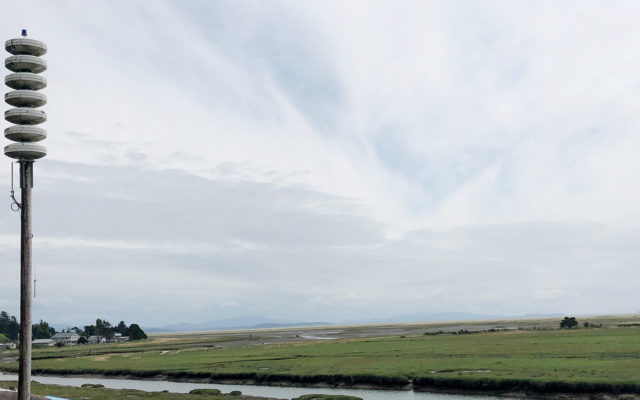Over a dozen new AHAB sirens added locally

16 new tsunami alert sirens have been added within our area, including 12 in Grays Harbor and 4 in Pacific County, to alert the public of an emergency situation, and all will be included in upcoming tests.
According to the Washington Military Department, the local additions were among 50 new All-Hazard Alert Broadcast (AHAB) sirens added throughout the state.
Officials state that the new installations fill gaps within the tsunami warning infrastructure, completing the statewide tsunami siren network.
“Without the funding from the Washington state Legislature and the hard work and dedication of partners across Western Washington, completing the siren network could have taken another 20 years.”
With these new units, there are now 122 sirens on the Washington coast, which are run and maintained by the state.
The state installed the first siren in 2005, and over the next 15 years, brought that number to 72. The last 50 sirens took about two years to install, which the state department calls “an unprecedented achievement”.
AHAB tsunami sirens are intended to act as an outdoor tsunami alerting method for people and communities on or near the coast who may not otherwise have access to other official alerting methods via radio, TV or their smartphones.
“This is especially helpful for “distant” tsunami events from places like Alaska, Japan or Southeast Asia. The tsunami sirens are NOT meant to be heard inside. Residents should invest in NOAA Weather Radios to hear tsunami alerts while inside their homes.”
The Washington Emergency Management Division coordinated with state, tribal and local partners to identify and fill the tsunami siren gaps for high risk communities.
Local partners may decide on their own to add more sirens as the years progress.
“This life-saving project brought together state agencies, tribal, county and city emergency management as well as other important stakeholders to ensure Washington’s coastal communities can be alerted in the event of a tsunami warning,” said Maximilian Dixon, the geologic hazards supervisor for the state Emergency Management Division.
Dixon says the state’s attention now will be to improve tsunami evacuation route signage, as well as working with local officials on vertical tsunami evacuation structures.
During a routine test of the tsunami siren system, which is conducted on the first Monday of every month at noon, all AHAB sirens are scheduled to play the Westminster Chimes (click here to listen to what it sounds like). The sirens are also tested once a year with the actual wail sound on the third Thursday in October on #ShakeOut Day (click here to listen to what it sounds like).
The 50 new tsunami sirens have been installed at the following places:
GRAYS HARBOR COUNTY – 12 SIRENS
- City of Aberdeen, West Hunley Street
- City of Aberdeen, Bishop Athletic Complex
- City of Aberdeen, Lafayette Street
- City Hoquiam, Queen Avenue
- Grayland Beach State Park
- Ocean City State Park
- Twin Harbors State Park
- City of Cosmopolis
- Ocean Shores, Central Water Reservoir
- Ocean Shores, Vacuum Pump Station #6
- Ocean Shores, Vacuum Pump Station #6
- City of Westport
PACIFIC COUNTY – 4 SIRENS
- Shoalwater Bay Tribe
- Ilwaco Marina
- Long Beach Peninsula, Pacific Park, Cranberry Beach Road
- Long Beach Peninsula, Pacific Park, 145th Place
CLALLAM COUNTY – 7 SIRENS
- Makah Tribal Housing Area
- Makah Tribe, Hobuck Campground and RV Resort
- Jamestown S’Klallam Tribe, Blyn
- Jamestown S’Klallam Tribe, Dungeness
- San Juan Vista Community
- Sekiu, Mason’s Olson Resort
- City of Port Angeles
JEFFERSON COUNTY – 1 SIREN
- Port Townsend Marina
WHATCOM COUNTY – 5 SIRENS
- Lummi Nation, Sandy Point
- Lummi Nation, Lummi Bay Market
- Blaine, Semiahmoo Spit Marina
- Birch Bay State Park
- Fairhaven Historic District, Bellingham
ISLAND COUNTY – 6 SIRENS
- Dugualla Bay, Whidbey Island
- Oak Harbor Marina, Whidbey Island
- Iverson Beach, Camino Island
- Driftwood Shores, Camino Island
- West Beach Road, Oak Harbor
- Keystone, Driftwood County Park
- Lagoon Point, Whidbey Island
SNOHOMISH COUNTY – 3 SIRENS
- Port of Everett Marina Park
- Port of Everett
- City of Edmonds
SKAGIT COUNTY – 11 SIRENS
- Swinomish Tribe, Shelter Bay Marina
- Swinomish Tribe, Tribal Casino
- Swinomish Tribal Fish Company
- Samish Indian Nation, Fidalgo Bay Resort
- City of Anacortes Skate Park
- City of La Conner Fire Station
- City of Blanchard
- Samish Island Community Center
- City of Anacortes, Skyline Marina
- Edison Fire Station
- City of Anacortes, Treatment Plant
FAQ from Washington Military Department
Why Sirens?
All 3,000 miles of Washington’s coastline are at risk of tsunamis. For local tsunamis, those caused by nearby earthquakes, the groundshaking is your warning that a tsunami could be on the way. However, for distant tsunamis, those caused by earthquakes in other parts of the world, there is no groundshaking to warn you about the approaching danger. Tsunami sirens therefore play an integral role in ensuring Washington’s public receives ample warning for distant events. The sirens have an audible range of approximately 1 mile, though this varies depending on environmental factors like topography, wind direction and physical barriers. The pole-mounted voice/tone sirens are also topped with a blue light for the hard of hearing. The sirens are not intended to be heard indoors.
Siren Testing
The siren system is tested on the first Monday of every month at noon. The sirens play the Westminster Chimes followed by an audio message in English and Spanish. The sirens are also tested once a year with the actual tsunami warning wail sound on the third Thursday in October in conjunction with the Great Washington ShakeOut earthquake and tsunami drill.
Know Your Tsunami Warning Signs
If you hear the siren wailing sound, or you receive a tsunami warning through your smartphone, TV, radio, or other alerting method, immediately follow the closest tsunami evacuation route inland or to high ground. This is your warning that a tsunami is approaching and you need to evacuate the inundation zone as soon as possible.
If you are on the coast and you feel ground shaking, drop, cover and hold on to protect yourself. When the shaking stops, immediately follow the closest tsunami evacuation route inland or to high ground. Do not wait to hear a tsunami siren or to receive an official tsunami alert – the shaking is your warning that a tsunami may be on its way.
To learn more about the AHAB tsunami siren network, and how you can prepare yourself and your loved ones for a tsunami, visit mil.wa.gov/tsunami.
View a map of the sirens at this link.



